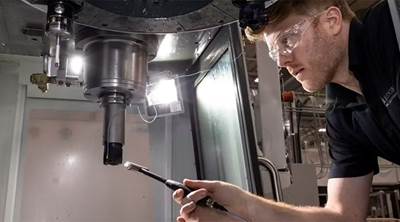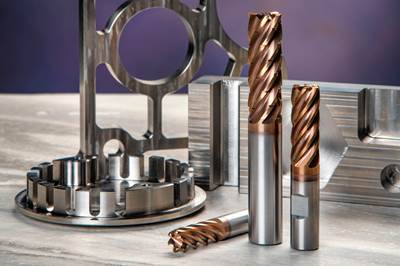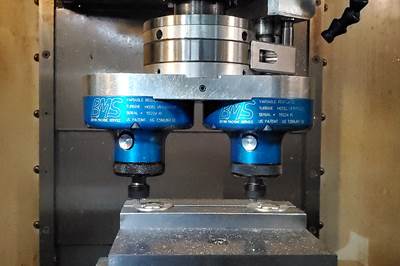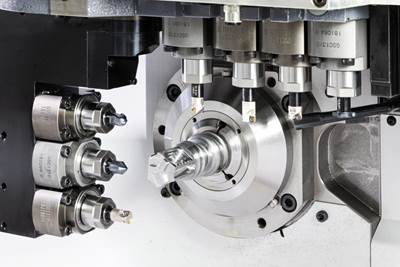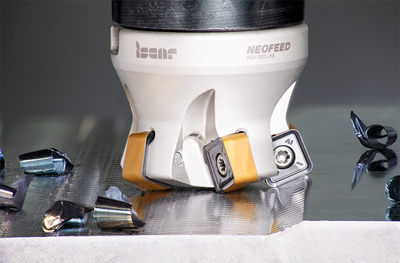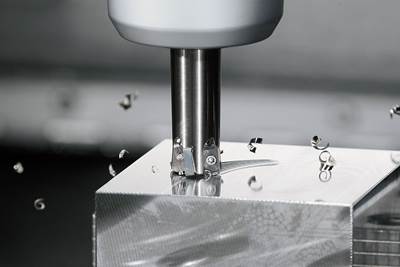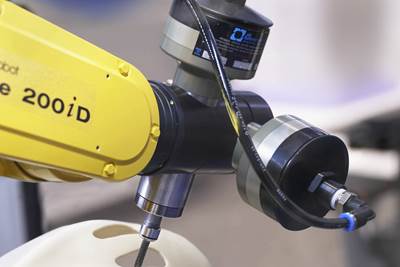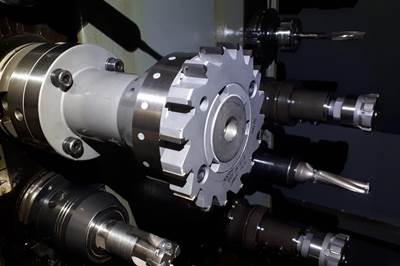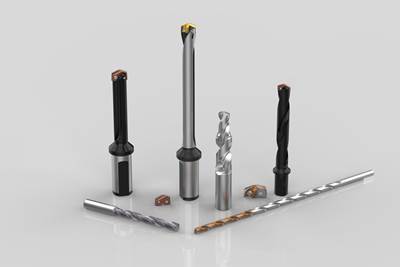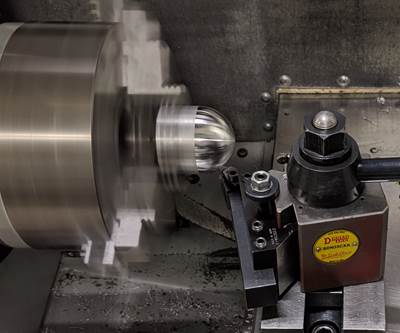Cutting Tools
The broad category of “cutting tools” includes all of the consumable tooling involved in milling, drilling, turning and other lathe and machining center operations. Drills, end mills, taps, reamers and inserts are all included here. Consumable tooling used on certain other types of machine tools is included here as well. Also found here are toolholders and closely related accessories such as angle heads. Supplier pages, FAQs related to cutting and cutting tools can be found here, as well as essential reading on the topic and all of the latest Modern Machine Shop cutting tools coverage.



Latest Cutting Tools News And Updates
Tungaloy Round-Insert Cutter Enhances Stability in Steel Machining
Tungaloy-NTK America Inc. expands its RoundSplit series with serrated cutting edge inserts and wear-resistant PVD grade AH3135 for improved surface finish in steel and stainless steel applications.
Read MoreHeule Holemaking Tool Enhances Precision on Uneven Surfaces
Heule Precision Tool’s Comp V3 is designed for drilling and countersinking uneven surfaces without marking, well suited for aerospace and others where critical finishes are required.
Read MoreAllied Machine Drill, Chamfer Holders Reduce Tool Changes
The T-A Pro product line now includes drill and chamfer holders, giving users the ability to drill and chamfer a hole in a single operation.
Read MoreTungaloy Milling Tools Optimize Wear, Fracture Resistance
The AH3225 grade features Tungaloy’s “Triple Nano Coating,” offering a combination of wear resistance, fracture toughness and oxidation resistance.
Read MorePlatinum Tooling Lineup Provides Machining Flexibility
Platinum Tooling’s premium lines include live tools and angle heads from Heimatec, Swiss-type collets/guide bushings from Tecnicrafts, mechanical, air and motor spindles from Henninger and Quick knurling and marking tools from Hommel + Keller.
Read MoreSeco Tools Face Milling System Provides Flexible Finishing Performance
The .38 Finishing Face Mill / SNFX1204 system features three cutter variants — fixed pocket, hybrid and adjustable — each tailored to different levels of control and performance.
Read MoreFeatured Posts
Understanding Process Damping in Milling Operations
Despite the advances in modeling machining operations over the past decades, process damping remains a topic of interest, including new tool designs that increase the effect.
Read MoreNew Possibilities from Process Consolidation, Customization, AI and More at MT Technology Series East 2025
When do broadening capabilities outweigh specialization (and vice versa)? In our recap of MT Technology Series East 2025, find out how the latest generation of machines, tooling and software answers that question.
Read MoreA New Frontier in Surface Finish Control
What if your machine tool could measure surface roughness as it cuts? This article explores how in-process metrology is advancing from concept to reality, enabling real-time feedback, immediate detection of anomalies and new levels of control over surface quality. Discover the technologies making this possible.
Read MorePicking the Right End Mill
Kennametal global product manager Katie Myers explains how cutting tool features can impact machining strategies for different materials.
Read MoreInside the Process of Cutting Tool Recycling
Global Tungsten & Powders, part of the Ceratizit Group, sheds light on the processing steps that convert a shop’s used inserts into new tools and other applications.
Read MoreFAQ: Cutting Tools
Why is through-tool coolant valuable, and why are shops are seeing greater need for it?
Getting coolant to the cutting edge is critical for any manufacturing application. It helps in cooling the cutting zone, provides very needed lubrication, and can assist in breaking a chip. Many times, external lines are used to splash coolant near the work zone. Long Chips can easily interfere with this delivery method, possibly knocking the lines out of the way. Additionally, when tools need to be changed or indexed coolant lines might be moved for better access to the tool. Then when the line is put back it is never the same as it previously was. Often times there is a give-and-take methodology used to cover areas being machined with this coolant, so all tools get some cooling, but none of them get ideal cooling. A coolant-through tool allows pinpoint accuracy with a specific direction of coolant pointed exactly at the cutting zone.
Through-tool coolant is available on cutters that couldn't offer it before. What has changed in the technology of tool manufacturing to make this possible?
There’s been a big change is the ability to drill small-diameter holes very deep and do this in a production atmosphere. Part of this comes from the drilling machines being able to reach the necessary speeds and holders that provide superior clamping and runout. The other part comes from tools designed specifically for this drilling application.
On a coolant-through tool, material could be added in areas that may need additional strength, allowing for the intersecting coolant ports to be drilled accordingly.
What aspect of tool engineering is responding to greater cutting speed?
Machines and tools seem to have a back-and-forth dance in terms of which is leading. Coatings continue to evolve, with more layers, and different material being used. This is something all tool manufactures are playing with on some level. The changes in coating technology is somewhat more limited, and not as many are playing in this arena. One process that comes to mind is “HiPIMS,” or high-power impulse magnetron sputtering. This process uses microsecond timing of extreme-power pulses. This allows the metal to ionize to nano size particles to be deposited on the tools. This process allows for greater adhesion and coating hardness, while maintaining great lubricity. Additionally, this process has greatly reduced compressive stresses. This reduction allows for smaller edge preps to be used, thus resulting in sharper tools.
Why is diamond used as an industrial cutting tool?
Developments in polycrystalline diamond (PCD) and cubic boron nitride (CBN) have allowed these materials to improve in ways that make them more versatile and cost-effective. Meanwhile, the machining speed and tool life of these tools continue to take machining processes to levels of performance where carbide cannot go.
Through long tool life and fast cutting parameters, the tools increase machine capacity by reducing the frequency of tool replacements and allowing machines to make parts at a greater rate. Meanwhile, the tooling increasingly figures into expert solutions tailored to more demanding applications in various industries.
Source: The New Rules of Cutting Tools - Rule #3: Diamond Shouldn't Be Rare
What are cutting tools made of?
Polycrystalline diamond (PCD), cubic boron nitride (CBN), ceramic, high-speed steel (HHS), cemented carbide or cermet.
Sources: What's Happening With Cutting Tools
Cutting Tools Supplier Categories
- Deburring Tools (Machine Tool Spindle-Mounted)
- Collets, Solid & Master
- Milling Cutters
- Tap Drivers & Attachments
- End Mills
- Tool Presetters
- Boring Tools & Heads for Machining Centers
- Spline Rolling Tools
- Tooling Materials, Ceramics
- Drills
- Drill Bushings
- Diamond Tools
- Mass Finishing Media & Compounds
- Spline Inserts
- Shear Blades
- Threading Tools - Cutting
- Facing Tools/Heads
- Tool Storage & Handling Systems
- Thread Chasers
- Boring Tools
- Punching Tools/Dies
- Collets for Toolholding
- Gear Cutting & Rolling Tools
- Cut-Off Tools/Attachments
- Grooving Tools
- Inserts, Indexable (Carbide, etc.) & Tool Inserts
- Tool Repair, Coating & Treatment Services
- Thread Whirling Tools
- Key Seating Tools
- Tooling Materials, Carbides
- Broaching Tools
- Taps
- Grinding Wheels & Belts
- Tooling Systems, Modular and/or Quick-Change
- Slotting Saws
- Thread Milling Cutters
- Endworking Tools
- Tool Blanks
- Burnishing Tools (Roller)
- Grinding Wheel Dressing Units
- Retention Knobs
- Drilling Heads/Attachments
- Threading Tools
- Honing & Lapping Tools
- Serration Tooling
- Protective Sleeves & Coatings (for Cutting Tools)
- Milling Heads/Attachments
- Tool Conditioning & Monitoring
- Form Tools
- Gundrills
- Burnishing, Honing & Lapping Tools
- Saw Blades
- Die & Mold Components
- Buffing & Polishing Supplies
- Knurling Tools
- Arbors (for Cutters)
- Counterbores/Countersinks
- Abrasive Compounds & Slurries
- Marking Tools
- Shaving Tools
- Boring Tools for Turning Machines
- Reamers
- Drill Chucks
- Toolholders
- Chamfering Tools
- Thread Rolls & Dies
- Threading Tools - Forming

















